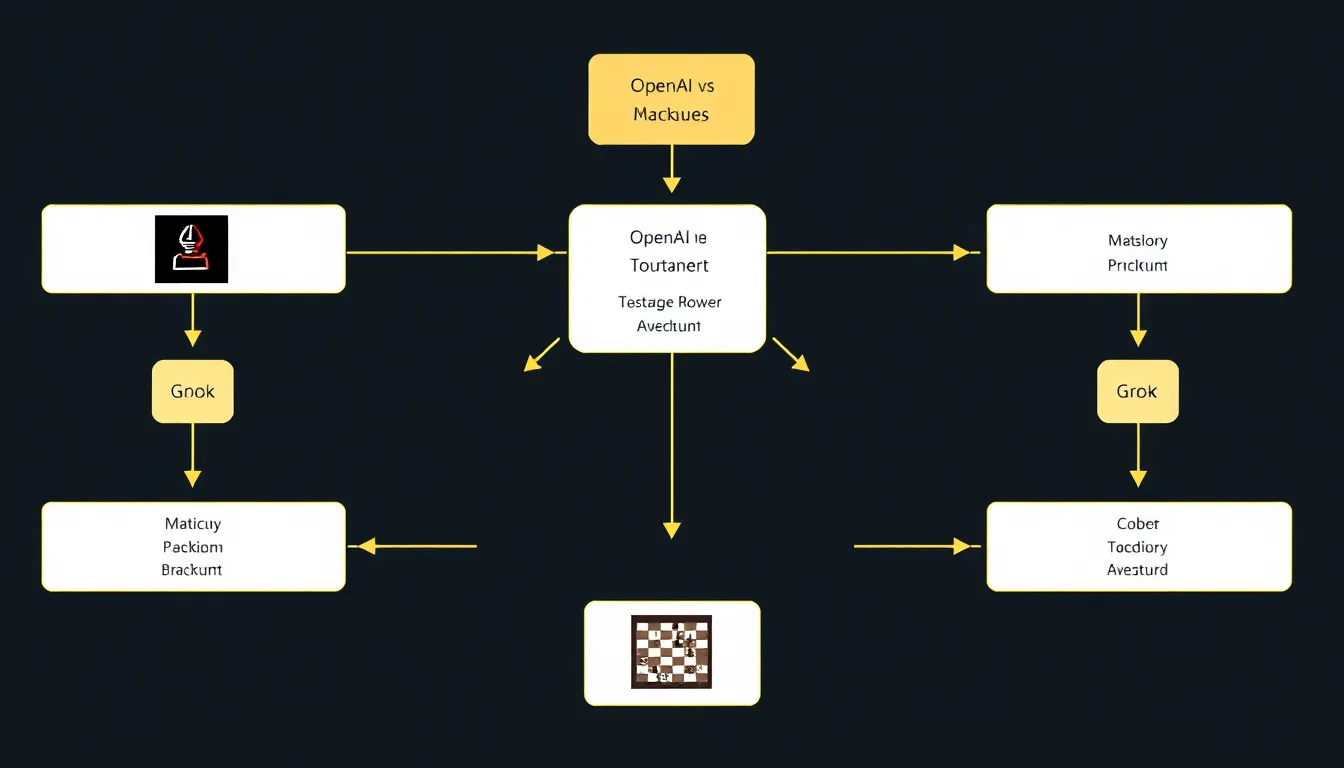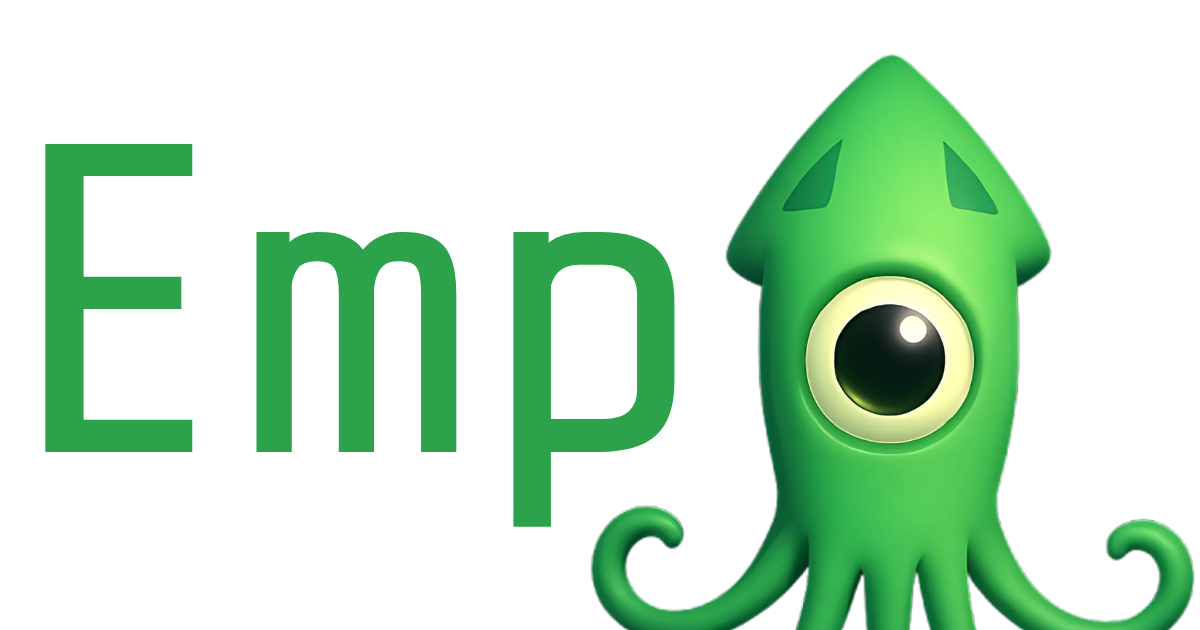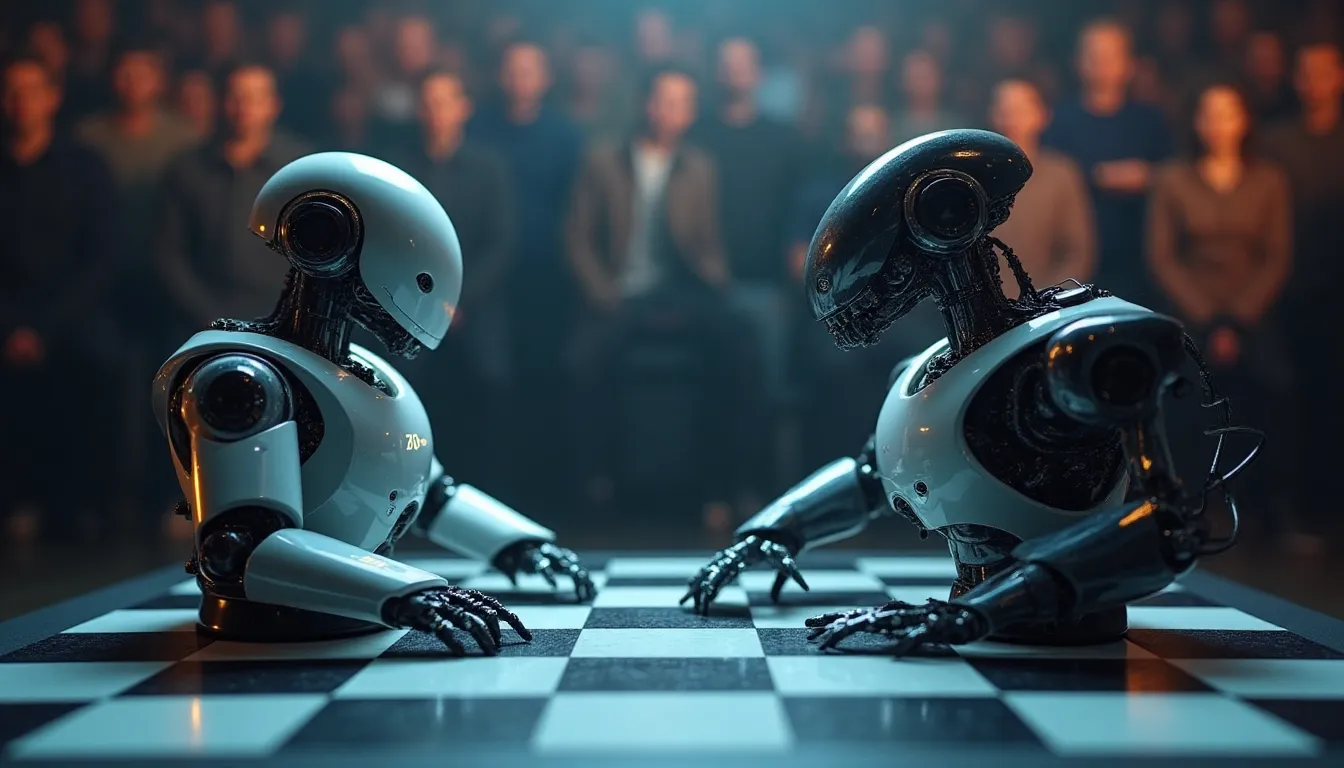In an age where artificial intelligence continues to redefine the landscape of technology and entertainment, AI chess tournaments stand as a fascinating battleground showcasing the brilliance of machine learning and strategic innovation. Each competition brings together the brightest minds and cutting-edge algorithms, igniting a competitive spirit that rivals traditional chess matches.
Recently, the excitement reached new heights as OpenAI triumphed over Elon Musk’s Grok in a riveting tournament hosted on Google-owned Kaggle. Participants included top AI models from leading companies such as Anthropic and Google, all vying for supremacy in the chess arena. This event not only displayed the remarkable advancements in AI capabilities but also highlighted the intense rivalry among these tech giants.
Join us as we delve deeper into this groundbreaking tournament, exploring the twists and turns that led to OpenAI’s victory, the dynamics of each match, and what this means for the future of AI in strategic gaming.
| Model Name | Company | Round Reached | Notable Performances |
|---|---|---|---|
| o3 | OpenAI | Final | Defeated Grok in the final match |
| Grok | xAI | Semi-Final | Strong performance, but several mistakes noted |
| Gemini | Third Place | Defeated another OpenAI model |

AI’s Impact in Chess
Artificial Intelligence (AI) has profoundly transformed competitive chess, offering both enhancements and challenges to the game.
Enhancements Brought by AI:
- Advanced Training Tools: AI-powered platforms like Chess.com and Lichess provide personalized training, real-time analysis, and move recommendations, enabling players to improve their skills efficiently. source
- Revolutionizing Strategy: AI engines such as AlphaZero have introduced novel strategies and opening ideas, challenging conventional wisdom and inspiring players to explore creative approaches. source
- Leveling the Playing Field: AI has democratized access to high-quality chess training and analysis, allowing players from diverse backgrounds to compete and improve, leading to a more inclusive and competitive chess community. source
- Enhanced Spectator Engagement: AI provides real-time analysis and commentary during live broadcasts, making complex positions more accessible and engaging for viewers. source
Challenges Introduced by AI:
- Diminished Human Creativity: Over-reliance on AI engines may stifle players’ creative and critical thinking abilities, leading to a more mechanical approach to the game. source
- Cheating Concerns: The accessibility of AI tools has made it easier for players to use engines during online games, undermining fair competition. Platforms like Chess.com have developed AI-based detection systems to monitor and address such issues. source
- Psychological Impact: The knowledge that AI can outperform humans may affect players’ confidence and approach to the game. source
Insights from Grandmasters:
Grandmaster Hikaru Nakamura’s perspectives on computers in chess encapsulate the evolving relationship between humans and AI. He stated, “Everybody uses computers to train so much now that the first nine or 10 moves of a match are made without thinking.” This highlights the deep integration of AI into player preparation and gameplay.
In summary, AI has significantly influenced competitive chess by enhancing training methods, introducing new strategies, and improving spectator engagement. However, it also presents challenges such as potential over-reliance, ethical concerns regarding fair play, and psychological impacts on players. Balancing AI’s benefits with these challenges is crucial for the continued growth and integrity of the game.
AI Adoption in Chess
The integration of artificial intelligence in chess has gained remarkable momentum over the past few years, fundamentally changing how players enhance their skills and analyze games. Although precise statistics on the total number of chess players utilizing AI tools for training and analysis are scarce, several significant trends highlight a clear shift towards AI adoption:
-
Active User Growth: Online chess platforms have seen explosive growth, with Chess.com increasing its active user base from 11 million in April 2023 to over 18 million by early 2025, totaling about 200 million registered users. This surge reflects an increase in player engagement with AI-powered tools and resources
(source). -
AI-Powered Training Tools: Chess engines such as Stockfish and AlphaZero have revolutionized the training landscape. These AI systems provide comprehensive game analysis, real-time performance feedback, and personalized recommendations, catering to players of all levels
(source). -
AI Coaching Applications: New applications like Caissa AI Coach from CircleChess epitomize the rise of AI-driven coaching tools, offering tailored feedback akin to traditional coaching while following user progress and game statistics
(source). -
Cloud-based Platforms: The advent of cloud-based chess platforms facilitates easy access to training and analysis resources, making AI tools more available to a broader audience. Platforms like Chess.com and Lichess provide features such as live games, move analysis, and educational content, further reinforcing the integrating trend of AI in chess
(source).
These developments indicate that AI is becoming an essential component of chess training and analysis, making high-quality resources and personalized mentoring accessible. The ongoing evolution of AI tools continues to enhance the chess experience, empowering both novice and advanced players alike to improve their skills and competitiveness in the game.
In summary, the adoption of AI in chess not only signifies a technological advancement but also points toward an increasingly analytical and data-driven approach to the game, shaping the future of chess for players around the globe.
Evolution of AI Chess Models Leading to the Tournament
The landscape of AI chess models has significantly evolved over the last few decades, transitioning from rudimentary algorithms to sophisticated artificial intelligence systems exemplified by models like OpenAI’s o3 and xAI’s Grok. This journey not only reshaped how chess is played and analyzed but also had profound implications for competitive chess tournaments.
Early Beginnings: Algorithms and Simple Engines
The story of AI in chess begins with foundational algorithms in the mid-20th century. One of the earliest noteworthy developments was ChipTest (1985), created at Carnegie Mellon University. ChipTest could analyze 50,000 moves per second, establishing a benchmark for future chess engines. This was followed by IBM’s Deep Blue, which made history in 1997 by defeating reigning world champion Garry Kasparov in a standard tournament match, marking a watershed moment for AI. The victory showcased the immense potential of AI in strategic and complex decision-making roles. source source
Advancements Through Neural Networks
The introduction of neural networks drastically transformed AI chess models. Google DeepMind’s AlphaZero (2017) revolutionized the field by employing deep reinforcement learning, showing that an AI could learn and master chess from scratch through self-play, surpassing traditional engines like Stockfish in mere hours. This model fundamentally changed how developers approached AI training strategies. source
Community-Driven Projects
Additionally, Leela Chess Zero (2018), inspired by AlphaZero, utilized community efforts to replicate its success. This open-source model demonstrated how collaborative development could yield AI systems capable of grandmaster-level play. source
Recent Innovations: Grok and o3
As the field advanced, so did the competencies of AI in chess. xAI’s Grok made significant strides as a powerful AI model utilized in corporate cloud services. Its competitive capabilities were displayed in tournaments, culminating in the recent Kaggle AI Chess Tournament where Grok competed fiercely against other models.
In August 2025, OpenAI’s o3 emerged victorious by defeating Grok 4 in the tournament final, showcasing how far AI chess models have advanced in strategy and adaptability. This event underscored a competitive environment among major players such as OpenAI, xAI, Google, and others, each pushing the boundaries of what AI can achieve in chess. source
In summary, the evolution of AI chess models reflects rapid technological advancements from basic algorithms to the sophisticated architectures present today. Key milestones, including Deep Blue’s victory and the introduction of neural networks, have played pivotal roles in enhancing both the capabilities and competitive applications of AI in chess. As AI continues to evolve, its impact on the game will only deepen, promising even more exciting developments in the future.
Final Match Summary: OpenAI’s o3 vs. Grok 4
In the climactic showdown of the Kaggle AI Chess Exhibition Tournament, OpenAI’s o3 faced off against xAI’s Grok 4, with o3 claiming a resounding victory with a clean sweep of 4-0. This final set showcased critical moments and strategic choices that defined the outcome of the match.
Game Highlights
- Game 1: The match began poorly for Grok 4, which blundered early, losing a bishop for no compensation. Instead of striving to regain material or creating complications, Grok 4 chose to exchange pieces, ultimately leading to a checkmate by o3 in just 35 moves.
- Game 2: The players embarked on the Poisoned Pawn variation of the Sicilian Defense. Grok 4 made a pivotal mistake, capturing a protected pawn with its queen, failing to recognize the established tactical dynamics. This oversight led to a quick loss for Grok 4.
- Game 3: Grok 4 played as White and adopted the Maroczy Bind structure. Although it started strongly, a critical blunder occurred when Grok played 11.Nd5??, wilting under pressure and losing its knight followed swiftly by its queen. This disastrous turn of events resulted in another swift defeat for Grok 4.
- Game 4: This was Grok 4’s best opportunity for a win; however, o3 blundered its queen early in the game. Despite this setback, o3 showcased remarkable recuperative skills by finding tactical resources to regain the queen. This resilience turned the tables, and o3 eventually converted the endgame into a victory.
Commentary and Insights
Prominent chess Grandmaster Magnus Carlsen provided commentary throughout the final, openly criticizing Grok 4’s performance and likening the games to “watching kids’ games.” He estimated Grok’s playing strength around 800 Elo and o3’s around 1200 Elo, highlighting the vast disparity in performance levels. Notably, he remarked, “Grok seemed to have learned theory but knows nothing else.”
Conclusion
The final match underscored the growing capabilities of specialized AI models like o3 compared to more generalized ones like Grok. Despite Grok’s earlier promising performances throughout the tournament, its final match appeared to reveal significant weaknesses, while o3 demonstrated superior strategic understanding and adaptability. Overall, OpenAI’s o3 not only won the tournament but performed exceptionally, setting a high standard for future AI chess competitions.
For more insights, you can read full details from Chess.com and The Indian Express.
Conclusion
The recent AI Chess Tournament has not only showcased the impressive capabilities of models like OpenAI’s o3 and xAI’s Grok but has also set a solid foundation for the future of artificial intelligence in competitive gaming. As these advanced algorithms continue to refine their strategic understanding, the potential for even more thrilling tournaments looms on the horizon. The competitive landscape is changing, and the excitement within the AI community is palpable, hinting at more aggressive rivalries and innovative technologies designed for chess and beyond.
Future tournaments will likely attract a greater number of participants, fostering an environment ripe for collaboration and competition. Not only will AI models enhance their gameplay quality, but they will also push the boundaries of strategic thinking and real-time decision-making in ways previously unimaginable.
As we reflect on this tournament, we invite technologists, game theorists, and enthusiasts to anticipate and engage in discussions about upcoming events. The advancements displayed in this competition herald an era where AI chess tournaments may become regular occurrences, offering a unique lens through which we can explore the intersection of technology and strategy. It is an exciting time for AI in competitive gaming, with endless possibilities waiting to be explored!
In an age where artificial intelligence continues to redefine the landscape of technology and entertainment, AI chess tournaments stand as a fascinating battleground showcasing the brilliance of machine learning and strategic innovation. Each competition brings together some of the brightest minds and cutting-edge algorithms, igniting a competitive spirit that rivals traditional chess matches. Recently, the excitement reached new heights as OpenAI triumphed over Elon Musk‘s Grok in a riveting tournament hosted on Google-owned Kaggle. Participants included top AI models from leading companies such as Anthropic and Google, all vying for supremacy in the chess arena. This event not only displayed the remarkable advancements in AI capabilities but also highlighted the intense rivalry among these tech giants. Join us as we delve deeper into this groundbreaking tournament, exploring the twists and turns that led to OpenAI’s victory, the dynamics of each match, and what this means for the future of AI in strategic gaming.
AI’s Impact in Chess
Artificial Intelligence (AI) has profoundly transformed competitive chess, offering both enhancements and challenges to the game.
Enhancements Brought by AI:
- Advanced Training Tools: AI-powered platforms like Chess.com and Lichess provide personalized training, real-time analysis, and move recommendations, enabling players to improve their skills efficiently.
- Revolutionizing Strategy: AI engines such as AlphaZero have introduced novel strategies and opening ideas, challenging conventional wisdom and inspiring players to explore creative approaches.
- Leveling the Playing Field: AI has democratized access to high-quality chess training and analysis, allowing players from diverse backgrounds to compete and improve, leading to a more inclusive and competitive chess community.
- Enhanced Spectator Engagement: AI provides real-time analysis and commentary during live broadcasts, making complex positions more accessible and engaging for viewers.
Challenges Introduced by AI:
- Diminished Human Creativity: Over-reliance on AI engines may stifle players’ creative and critical thinking abilities, leading to a more mechanical approach to the game.
- Cheating Concerns: The accessibility of AI tools has made it easier for players to use engines during online games, undermining fair competition. Platforms like Chess.com have developed AI-based detection systems to monitor and address such issues.
- Psychological Impact: The knowledge that AI can outperform humans may affect players’ confidence and approach to the game.
In summary, AI has significantly influenced competitive chess by enhancing training methods, introducing new strategies, and improving spectator engagement. However, it also presents challenges such as potential over-reliance, ethical concerns regarding fair play, and psychological impacts on players. Balancing AI’s benefits with these challenges is crucial for the continued growth and integrity of the game.

